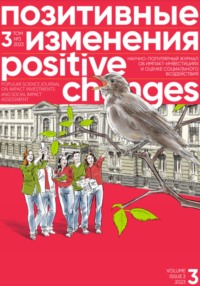
Позитивные изменения. Том 3, № 3 (2023). Positive changes. Volume 3, Issue 3 (2023)
46
Решетников, О. В. (2016). Конструирование и проектирование социальной реальности: от замысла к воплощению. Местное право, (3), 79–90.
47
Гаете Сепулведа, М. А. (2022). Обучение служением через проектно-прикладную деятельность. Методические рекомендации для университетов. Режим доступа: http://cpo.samgtu.ru/sites/cpo.samgtu.ru/files/obuchenie_sluzheniem_vshe.pdf. (дата доступа: 18.08.2023).
48
Президент России. (2022). Перечень поручений по итогам заседания Госсовета. Режим доступа: http://www.kremlin.ru/acts/assignments/orders/70421. (дата доступа: 18.08.2023).
49
Минобрнауки России. (2022). Более 180 представителей вузов завершили программу повышения квалификации для внедрения курса «Обучение служением». Режим доступа: https://minobrnauki.gov.ru/press-center/news/obrazovanie/70234/. (дата доступа: 18.08.2023).
50
Решетников, О. В. & Тетерский, С. В. (2020). Обучение служением: Методическое пособие. Режим доступа: https://minobrnauki.gov.ru/files/Metodicheskoe_posobie_Obuchenie_sluzheniem.pdf. (дата доступа: 18.08.2023).
51
Методические рекомендации по реализации модуля «Обучение служением» в образовательных организациях высшего образования Российской Федерации. (2023). Режим доступа: https://nark.ru/upload/iblock/7bb/v3x8h3ar13°5umz1woovwwrgvdnhgyjf/Metod_rekomendatsii_Obuchenie-sluzheniem.pdf. (дата доступа: 26.08.2023).
52
Санкт-Петербургский государственный университет. (2023). Практика по модели клиники в СПбГУ. Режим доступа: https://spbu.ru/studentam/praktika-po-modeli-kliniki-v-spbgu. (дата доступа: 25.08.2023).
53
Лаврикова, М. Ю. & Русакова, М. М. (2021). Современный рынок труда и образование: клинический подход как ответ на потребность изменений в обучении. Режим доступа: https://spbu.ru/sites/default/files/kliniki_spbgu.pdf. (дата доступа: 25.08.2023).
54
Gladkikh, N. Yu. (2020). Report on the research work “Practices of university participation in the development of social innovation: international experience.” Retrieved from: https://drive.google.com/file/d/1n9Im6fuNdfjZ2oSZY9AKvB-kZ0VR_f4k/view. (accessed: 18.08.2023).
55
Reshetnikov, O. V. (2016). Constructing and designing social reality: from concept to realization. Local Law, (3), 79–90.
56
Gaete Sepulveda, M. A. (2022). Service learning through project and application activities. Methodological guidelines for universities. Retrieved from: http://cpo.samgtu.ru/sites/cpo.samgtu.ru/files/obuchenie_sluzheniem_vshe.pdf. (accessed: 18.08.2023).
57
President of Russia. (2022). List of instructions following the results of the State Council meeting. Retrieved from: http://www.kremlin.ru/acts/assignments/orders/70421. (accessed: 18.08.2023).
58
Ministry of Education and Science of Russia. (2022). Over 180 university representatives have completed a professional development program to implement the Service Learning course. Retrieved from: https://minobrnauki.gov.ru/press-center/news/obrazovanie/70234/ (accessed: 18.08.2023).
59
Reshetnikov, O. V. & Tetersky, S. V. (2020). Service Learning: A methodological guidebook. Retrieved from: https://minobrnauki.gov.ru/files/Metodicheskoe_posobie_Obuchenie_sluzheniem.pdf. (accessed: 18.08.2023).
60
Methodological recommendations for the implementation of the Service Learning module in higher education organizations in the Russian Federation. (2023). Retrieved from: https://nark.ru/upload/iblock/7bb/v3x8h3ar13°5umz1woovwwrgvdnhgyjf/Metod_rekomendatsii_Obuchenie-sluzheniem.pdf (accessed: 26.08.2023).
61
Saint Petersburg State University. (2023). Practice in the clinic format at St. Petersburg State University. Retrieved from: https://spbu.ru/studentam/praktika-po-modeli-kliniki-v-spbgu (accessed: 25.08.2023).
62
Lavrikova, M. Yu. & Rusakova, M. M. (2021). Modern labor market and education: a clinical approach as a response to the need for changes in training. Retrieved from: https://spbu.ru/sites/default/files/ kliniki_spbgu.pdf. (accessed: 25.08.2023).
63
Анализу понятия «третьей миссии» посвящена статья Е. В. Кудряшовой и С. Э. Сорокина «Третья миссия» университетов как предмет научного анализа», в которой, помимо историографического обзора, приведена библиография отечественных и зарубежных работ по этой теме.
64
An analysis of the notion of the third mission is presented in the article by E. V. Kudryashova and S. E. Sorokin, titled “The Universities’ Third Mission as a Subject of Scholarly Analysis,” which, besides offering a historiographical overview, provides a listing of domestic and foreign works in this area.
65
Brock, D. D. & Steiner, S. (2009). Social entrepreneurship education: is it achieving the desired aims?. Retrieved from: https://ssrn.com/abstract=1344419. (accessed: 11.08.2023). http://dx.doi.org/10.2139/ssrn.1344419Available at SSRN 1344419.
66
Фонд «Наше будущее» & НИУ ВШЭ. (2021). Университеты и социальное предпринимательство. Формирование партнерства университетов, ЦИСС и других субъектов развития социального предпринимательства: аналитический отчет. Режим доступа: http://nb-forum.ru/uploads/images/documents/137_a33f3.pdf. (дата доступа: 11.08.2023).
67
The British Council. (2016). Social Enterprise in a Global Context: The Role of Higher Education Institutions. Country Brief: California, USA. Retrieved from: htps://www.britishcouncil.org/sites/default/files/usa_california_-_social_enterprise_in_a_ global_context_-_final_report.pdf. (accessed: 11.08.2023).
Вы ознакомились с фрагментом книги.
Для бесплатного чтения открыта только часть текста.
Приобретайте полный текст книги у нашего партнера:
Всего 10 форматов